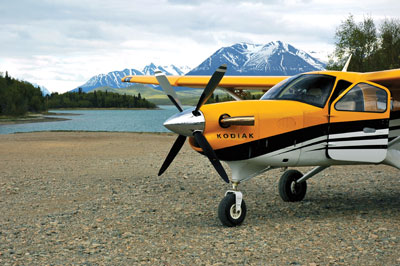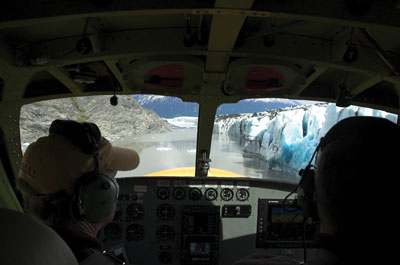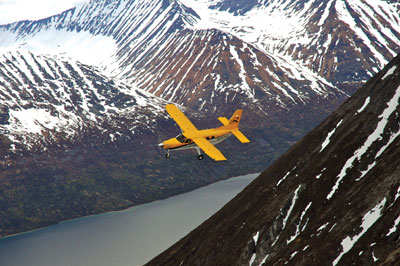
Features
Operations
Experiencing a Kodiak moment
Not often does one rumble through a gravel parking lot to the doorstep of an aircraft manufacturer.
March 6, 2013 By James Marasa
Not often does one rumble through a gravel parking lot to the doorstep of an aircraft manufacturer. That being said, in the shadow of the Selkirk mountain range on the shores of Idaho’s Lake Pend Oreille, the setting seemingly fits. After all, rough terrain was what the Kodiak was built for.
 |
|
| Quest is delivering two aircraft per month with production slated to gear up in 2013. PHOTOs: Quest Aircraft
|
Quest Aircraft’s roots in mission and humanitarian aviation hang as tributes in the otherwise simply adorned 84,000-square-foot facilities in Sandpoint, about an hour south of the Canadian border.
A humble reception area is in keeping with Quest’s foundations. Tom Hamilton, founder of the Glasair, teamed up with veteran missionary pilot Dave Voetmann in 1998 to build a new-generation aircraft that could respond to the challenges faced by single-engine aircraft in some of the world’s most inhospitable regions. Initial funding for the Kodiak was raised on the idea that commercial sales could subsidize one of every 10 airplanes to be put to use by non-profit humanitarian organizations.
Dave Rask, director of aviation resources with Mission Aviation Fellowship (MAF) in Nampa, Idaho says the Kodiak was seen as the most beneficial way to bolster a fleet comprising largely Cessna 206s.
“We needed an aircraft that could land in the same airstrips as a 206, carry twice the payload and fly faster with a greater margin of safety,” he says. “We got all of that in the Kodiak.”
There was also a pressing need to move away from reliance on Avgas, which can be scarce in many of the areas of the world where MAF operates. When available, Avgas can cost upwards of $20 per gallon in certain regions.
“When you look at the money spent on an aircraft, you spend more on fuel than on anything else,” says Rask. “If you cut fuel costs, you get a huge savings and that is what we have seen with the Kodiak.”
Given that the Kodiak was conceived for operations far away from major centres, ease of maintenance had to be considered. A PT6 turbine engine which one Quest pilot referred to as “bulletproof” was incorporated, as were an abundance of inspection plates on the airframe to accommodate work needing to be done in the field.
Up close and personal
It’s one thing to read about what an aircraft is capable of and quite another to see it for yourself. So after I got familiar with the aircraft on paper, Quest’s engineering test pilot, Kenny Stidham, showed me what the Kodiak could really do.
 |
|
| The Kodiak’s wing design provides a significant margin of safety when manoeuvring at low speeds near the ground.
|
Backtracking on Sandpoint’s 5,500 foot paved runway, Stidham spun the aircraft around at the threshold and briefed me on a maximum-performance takeoff. Releasing the brakes with 750 horsepower roaring on the four-bladed prop, the Kodiak vaulted off the runway and the VSI reached for 2,000 feet per minute. Obstacle clearance was a non-issue. Stidham lowered the nose to a cruise climb of 100 knots and 1,500 feet per minute. “What was the ground-roll? 300 feet?” I asked. “Yeah about that,” Stidham said.
Quest publishes a power loading of nine pounds per horsepower on the Kodiak.
“We have a better power-to-weight ratio than the competition,” said Stidham. “Even at gross-weight, the aircraft doesn’t feel like it is. We would still be airborne in around 700 feet.” I asked what the competition was and Stidham just smiled. “We have a bit of a niche,” he said.
Indeed, the Kodiak came about to fill a gap in the commercial market. As a 10-place single-engine turboprop, design similarities to the Caravan were unavoidable, but Quest doesn’t like the comparison. Stidham said the Caravan is well suited to hauling heavy loads off paved surfaces, but that the Kodiak was designed specifically for the backcountry.
“The Kodiak will go places a Caravan won’t,” he said. When equipped with 29 x 11-inch main tires, the Kodiak certainly feels at home on unimproved surfaces.
Primed to perform
At a cruising altitude of 12,000 feet, fuel flow is roughly 300 pounds-per-hour with a true airspeed in the range of 170 to 175 knots. The speed is nothing to sneeze at for a fixed-gear, single-engine airplane, but at its core this is an STOL aircraft. Superior Airways of Red Lake, Ont. acquired a Kodiak as a replacement for its Piper Chieftain.
 |
|
| To meet the needs of humanitarian organizations such as Mission Aviation Fellowship, the Kodiak was designed to land in the same airstrips as a 206, carry twice the payload and fly faster with a greater margin of safety.
|
“I really like the wing,” said president Mike Misurka. “Whoever designed it knew what they were doing.”
The Kodiak wing flaunts impressive aileron control approaching a stall due to the discontinuous leading edge. The outward section of the wing droops forward at a lower angle of incidence than the inward section. A feature familiar to Cirrus owners, the design provides a significant margin of safety when manoeuvring at low speeds near the ground.
According to Quest, the outer section of the airfoil provides lift and full aileron control at airspeeds lower than comparably sized airplanes can fly.
Stidham demonstrated the Kodiak’s slow flight and stall characteristics at altitude. With flaps down and an approach power setting, the aircraft did not stall until an indicated airspeed of 40 knots. Even then, there was no real tendency for a wing drop, nor did rolling with aileron in one direction or the other aggravate the stall. Recovery to cruise was brisk.
Stidham inputted a flight plan on the Garmin G1000. A magenta “highway in the sky” appeared on the synthetic vision above the artfully pixelated mountains of Northern Idaho.
“It does what I’ve always felt an airplane should do,” said Stidham. “I can bring the power right back from cruise and push the props full forward if I need to get down,” which Stidham did without the Kodiak missing a step. We descended for the Magee airstrip, a half-mile high, 2,400-foot grass field in a valley near Coeur d’Alene.
Synthetic vision is nothing new to business jets, but for an aircraft designed to operate in the bush it’s something special. Garmin’s 3-D rendering of the earth’s surface coupled with a terrain-awareness and warning system (TAWS) comes standard on the G1000 of every Kodiak.
“It allows you to make better decisions when navigating in low-visibility,” said Stidham. And if the weather calls for the Kodiak to be operated IFR, the aircraft can come equipped with TKS ice protection.
The approach to Magee was low and slow between the rolling hills, with the TAWS eagerly drawing attention to the hazardous terrain surrounding the field. The runway became visible only on the turn to final. At 70 knots with downdrafts and a strong potential for wind shear it was comforting to know the discontinuous leading edge works the way it’s supposed to. The aircraft touched down smoothly and as Stidham slid the eight-foot prop into beta, deceleration was rapid with plenty of field to spare. It truly felt like you could go anywhere in this airplane.
Delivering on its promise
At the time of writing, Quest had delivered 75 Kodiaks with three so far in Canada.
Though close to 20 per cent of the total orders have been for aircraft on amphibious floats, it caught me by surprise when Stidham referred to the Kodiak as “the modern-day Beaver.” Quest’s director of sales and marketing, Steve Zinda, echoed that claim.
“We have great respect for the Turbo Beaver. The Kodiak design has taken some of the Turbo Beaver’s best features and brought them into the 21st century.”
Comparisons to the legendary Canadian workhorse are bound to raise eyebrows. That being said, a public procurement process determined that an amphibious Kodiak would best meet the needs of the RCMP’s operations in Northern British Columbia.
In 2011, the RCMP acquired a Kodiak as a replacement for its old Turbo Beaver in Prince George.
Neil Penny, a civilian pilot who flies the RCMP Kodiak, says the aircraft has exceeded a lot of expectations. “I love it . . . the speed is awesome,” he says of the 155 knots true airspeed in cruise. “That’s very fast for a float plane.”
The safety principle
Due largely to the avionics, Penny claims the Kodiak is a much safer airplane than the legacy float aircraft he has flown. He lauds the Kodiak’s range and endurance for the type of missions the RCMP is tasked with, especially search and rescue. “It has much greater range than the Turbo Beaver. We used to have a fuel cache at Tsay Keh (250 nautical miles northwest of Prince George) but with the Kodiak, we don’t need it anymore.”
After a 2008 recession that took the floor out of aircraft orders in the domestic United States, Quest hung on through some lean years. Today, Quest is delivering two aircraft per month with production slated to gear up in 2013. Attention has been readdressed overseas with much interest now coming internationally. A backorder list about three months long includes aircraft to be ferried as far as Thailand, Panama, Brazil and China. Zinda points out that a partnership with Northrop Grumman is evidence of how the Kodiak is penetrating new markets. A surveillance version of the Kodiak, known as the Air Claw, is being shopped to law enforcement agencies and militaries in developing economies. At $1.7 million U.S. before the surveillance retrofit, the Kodiak costs less than other airborne platforms.
Quest set out to create an aircraft with a purpose. The philosophy behind the creation was that the aircraft would be able to effectively serve people who could least afford it. The hope was that commercial success of the aircraft could augment that mission. The concept – like the aircraft – is unique, but in rough terrain and rough times, the Kodiak has clawed its way through.
| Kodiak Specifications
Weights Max. Takeoff Weight – 7,255 lbs. Base Aircraft Useful Load – 3,535 lbs. Fuel Capacity – 320 gal./2,144 lbs. Max. Wing Loading – 30.1 lbs./sq. ft. Max. Power Loading – 9.67 lbs./hp
|